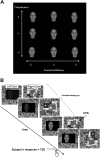Unconscious evaluation of faces on social dimensions
- PMID: 22468670
- PMCID: PMC3496403
- DOI: 10.1037/a0027950
Unconscious evaluation of faces on social dimensions
Abstract
It has been proposed that two major axes, dominance and trustworthiness, characterize the social dimensions of face evaluation. Whether evaluation of faces on these social dimensions is restricted to conscious appraisal or happens at a preconscious level is unknown. Here we provide behavioral evidence that such preconscious evaluations exist and that they are likely to be interpretations arising from interactions between the face stimuli and observer-specific traits. Monocularly viewed faces that varied independently along two social dimensions of trust and dominance were rendered invisible by continuous flash suppression (CFS) when a flashing pattern was presented to the other eye. Participants pressed a button as soon as they saw the face emerge from suppression to indicate whether the previously hidden face was located slightly to the left or right of central fixation. Dominant and untrustworthy faces took significantly longer time to emerge (T2E) compared with neutral faces. A control experiment showed these findings could not reflect delayed motor responses to conscious faces. Finally, we showed that participants' self-reported propensity to trust was strongly predictive of untrust avoidance (i.e., difference in T2E for untrustworthy vs neutral faces) as well as dominance avoidance (i.e., difference in T2E for dominant vs neutral faces). Dominance avoidance was also correlated with submissive behavior. We suggest that such prolongation of suppression for threatening faces may result from a passive fear response, leading to slowed visual perception.
(PsycINFO Database Record (c) 2012 APA, all rights reserved).
Figures




References
-
- Adams R. B. Jr., Gordon H. L., Baird A. A., Ambady N., & Kleck R. E. (2003, June 23). Effects of gaze on amygdala sensitivity to anger and fear faces. Science, 300, 1536. doi:10.1126/science.1082244 - PubMed
-
- Adams R. B. Jr., & Kleck R. E. (2003). Perceived gaze direction and the processing of facial displays of emotion. Psychological Science, 14, 644–647. doi:10.1046/j.0956-7976.2003.psci_1479.x - PubMed
-
- Adams W. J., Gray K. L., Garner M., & Graf E. W. (2010). High-level face adaptation without awareness. Psychological Science, 21, 205–210. doi:10.1177/0956797609359508 - PubMed
-
- Adolphs R., Tranel D., Damasio H., & Damasio A. (1994, December 15). Impaired recognition of emotion in facial expressions following bilateral damage to the human amygdala. Nature, 372, 669–672. doi:10.1038/372669a0 - PubMed
-
- Allan S., & Gilbert P. (1997). Submissive behaviour and psychopathology. British Journal of Clinical Psychology, 36, 467–488. doi:10.1111/j.2044-8260.1997.tb01255.x - PubMed

